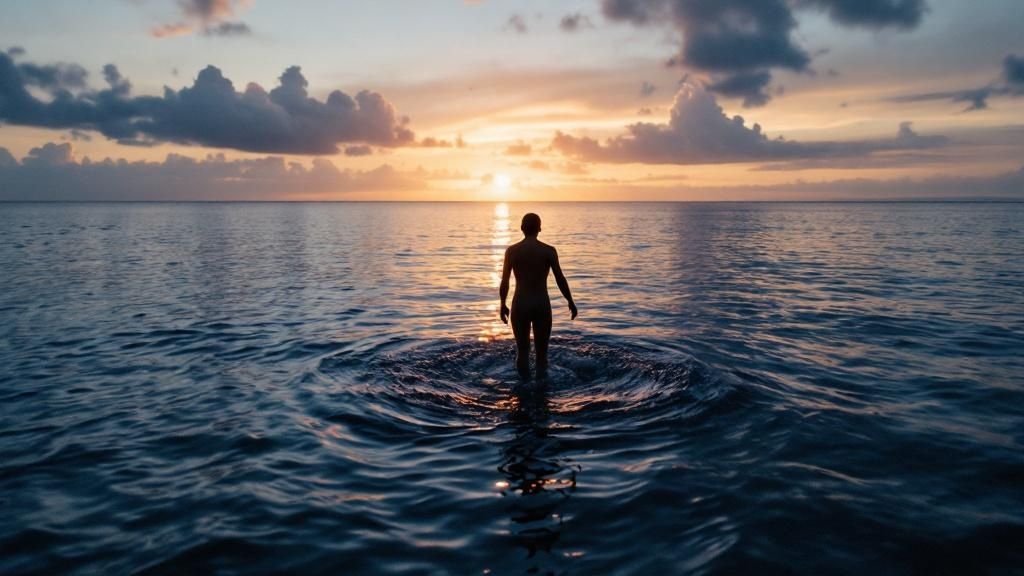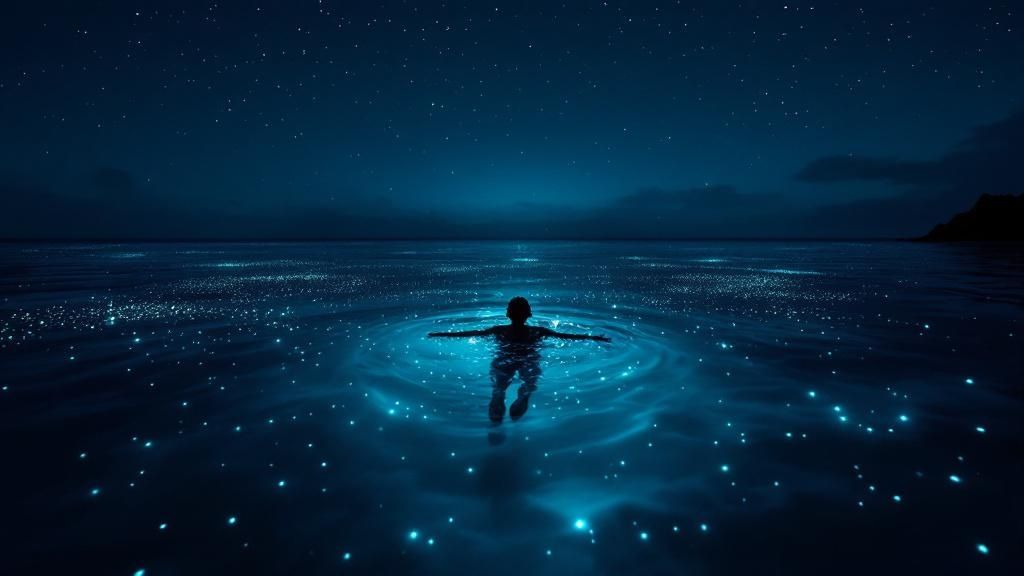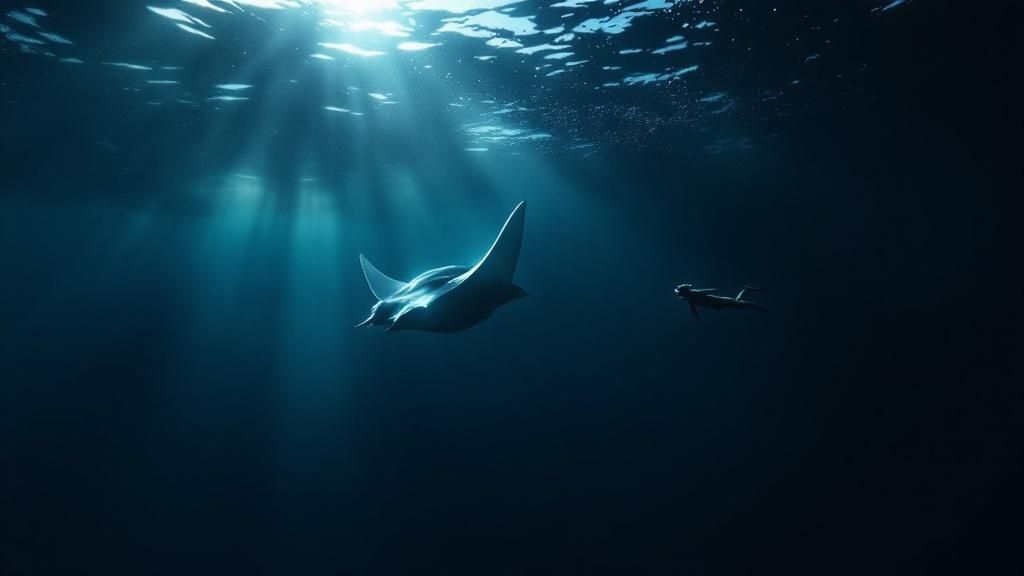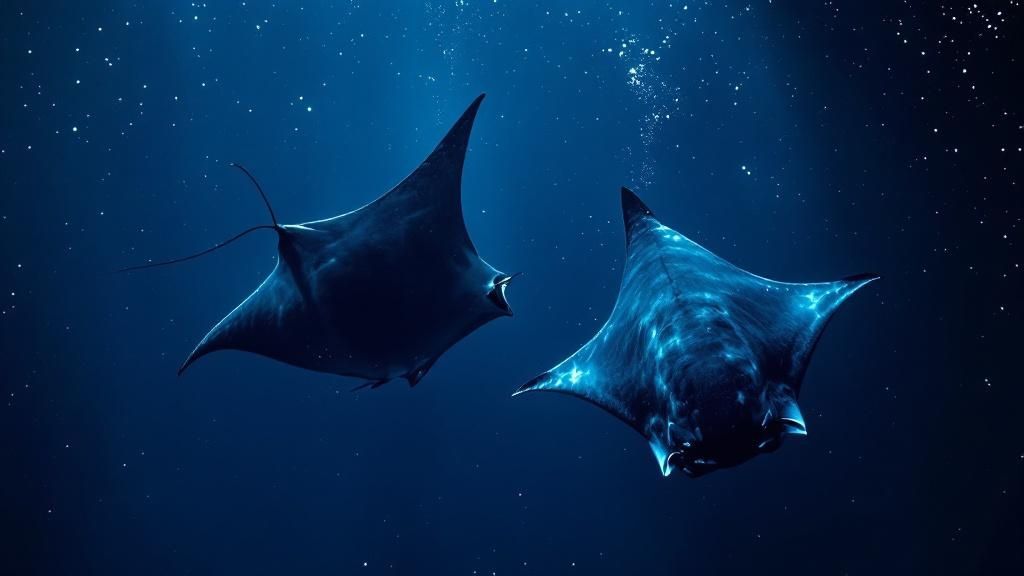Manta Ray Night Snorkel Kona | Unforgettable Ocean Adventure

Picture this: you’re floating effortlessly in the warm, dark Pacific Ocean. Suddenly, a majestic manta ray, with a wingspan wider than a car, glides silently just inches below you. This isn't a scene from a documentary; it's the magic of the manta ray night snorkel in Kona, a truly unforgettable, once-in-a-lifetime experience. This guide will walk you through everything you need to know to make this incredible adventure happen.
As Hawaii's top-rated & most-reviewed snorkel company, Kona Snorkel Trips is the expert in creating these magical encounters. See what our guests have to say:
Your Unforgettable Kona Manta Ray Adventure Starts Here
We're going to dive deep into what makes this trip so special. You'll get the inside scoop on why this encounter is consistently amazing and how to choose the best possible tour for you and your family.

We'll introduce you to Kona Snorkel Trips, Hawaii's top-rated and most-reviewed snorkel company. Their commitment to safety, sustainability, and creating a mind-blowing experience really sets them apart.
Why This Kona Experience Is So Unique
Kona isn't just a good place to see manta rays; it's hands-down one of the most reliable and accessible spots on the entire planet for this kind of encounter. It's become such a cornerstone of Big Island tourism for one simple reason: it works!
The secret is a unique, almost symbiotic relationship that has developed over decades. The mantas are drawn to specific spots along the coast where tour operators set up powerful, submerged lights. These lights attract swarms of plankton—the mantas' favorite food—creating a dependable underwater buffet that the gentle giants visit almost every single night.
The success of this human-wildlife interaction is incredible. The Kona manta ray night snorkel draws in around 80,000 visitors every year, a huge testament to just how reliable and awe-inspiring it is.
Tour data consistently shows a ridiculously high sighting success rate, often hovering between 85-95%. This means on almost any given night, you have an excellent chance of having your mind completely blown.
What to Know Before You Go
Planning your manta ray night snorkel in Kona is surprisingly simple, but a few key details will help you feel totally prepared for the adventure. The whole experience is designed to be safe and awe-inspiring, even if you’ve never put on a snorkel mask in your life. To get a feel for the magic, check out our complete overview on what makes manta ray snorkeling in Kona so unforgettable.
Here’s a quick rundown of what your adventure will look like:
- No Experience Needed: Seriously. You don't even need to be a strong swimmer. You'll hold onto a custom-made floating light board, which gives you perfect stability and also happens to be what attracts the mantas.
- All Gear Provided: Good tours give you everything you need. This includes a quality mask, snorkel, and a wetsuit. The wetsuit is a game-changer for staying warm and comfortable in the water.
- An Evening Activity: The whole trip usually takes about two hours, with around 45 minutes spent in the water with the mantas. It's the perfect evening adventure.
- Focus on Safety: The entire trip is supervised by an expert crew. Their job is to keep you safe and ensure the well-being of the incredible manta rays you're there to see.
To help you get a quick snapshot of the experience, here's a handy table with all the key details.
Kona Manta Ray Snorkel At a Glance
This table breaks down the essentials so you can see exactly what to expect from this bucket-list adventure.
| Aspect | Details |
|---|---|
| Activity | Night snorkeling with wild manta rays |
| Location | Designated viewing sites off the Kona coast |
| Best Time | Year-round, with calmest waters April-October |
| Duration | Approx. 2 hours total (45 mins in water) |
| Experience Needed | None; non-swimmers are welcome |
| Key Attraction | Close, passive encounters with feeding manta rays |
| What's Provided | Snorkel gear, wetsuit, flotation device, expert guides |
| Sighting Rate | Very high, typically over 90% success |
Ultimately, it’s an expertly managed, safe, and profoundly moving experience that connects you with one of the ocean's most graceful creatures.
What to Expect During Your Manta Ray Encounter

The thought of floating around in the dark ocean can be a little intimidating, I get it. But knowing what’s coming on a manta ray night snorkel in Kona can turn that mystery into pure, giddy excitement. The whole trip is set up to be incredibly safe, comfortable, and downright mesmerizing. Let's walk through exactly how the adventure unfolds.
Your night begins at the harbor, usually right as the Hawaiian sun puts on its nightly show, painting the sky with fiery oranges and purples. It's the perfect photo op. Once you're on board, you'll meet the crew—your expert guides for the evening.
As the boat cruises out to the manta site, they'll give you a full safety rundown. They cover everything: the gear, how to get in and out of the water, and most importantly, the golden rules for being a respectful guest in the mantas' world. They’ll also share some incredible facts about these gentle giants, building the anticipation for what’s to come.
The Underwater 'Campfire'
Once the boat is anchored, the real magic begins. The crew sets up a special, floating light board. I like to think of it as an underwater "campfire." It shines a powerful, but soft, light down into the dark water, and this light is the secret to the whole experience.
Those bright beams attract huge clouds of phytoplankton—the microscopic critters that manta rays love to eat. For the mantas, this glowing light show is an irresistible, all-you-can-eat buffet.
Your job as a snorkeler couldn't be easier. You just hop in the water and hold onto the handles of the light board. It’s super stable, so you don’t need to swim or kick. You just float and watch the show unfold right beneath you.
This brilliant design means that even if you're not a strong swimmer, you can join in safely. You just float on the surface, peer down through your mask, and wait for the stars of the show to make their grand entrance.
The Grand Arrival and Graceful Ballet
It usually starts with a shadow, a flicker of movement on the edge of the light. Then, one by one, the majestic manta rays glide out of the darkness. They're drawn in by that dense cloud of plankton, and what happens next is a silent, hypnotic ballet that you have a front-row seat for.
To scoop up as much plankton as possible, the mantas perform these incredible barrel rolls and giant, swooping loops. They’ll glide, turn, and somersault just inches below you, their huge mouths wide open. It’s an unbelievably intimate and awe-inspiring thing to see these massive creatures move with such grace right in front of your face.
You’ll be shocked at how close they get, sometimes even making what feels like eye contact as they pass by. It’s a peaceful, surreal encounter that forges a real connection with one of the ocean's most amazing animals. To get an even deeper look at the mechanics of it all, check out our guide on snorkeling with manta rays in Kona.
The whole experience is designed for passive observation, letting the mantas do their thing completely naturally while you witness their nightly feast. It’s truly something you will never, ever forget.
How to Choose the Best Manta Ray Tour in Kona

Picking the right operator for your manta ray night snorkel in Kona is hands down the most important decision you'll make. The right company can take a cool activity and turn it into a memory that lasts a lifetime. With a bunch of boats to choose from, knowing what to look for is the key to making sure your adventure is safe, comfortable, and absolutely magical.
Small Group vs. Large Vessel
One of the first things you'll want to figure out is the kind of vibe you're going for. When you're picking an operator, think about whether you want a more intimate experience or if you'd prefer the stability of larger group tour options.
-
Small-Group Tours: These trips, often on zippy rafts or smaller boats, give you a much more personal feel. With fewer people on board, you get more one-on-one time with the guides and a front-row, less-crowded view of the mantas. This is a fantastic choice for families, photographers, or anyone who wants to feel a deeper connection to the experience.
-
Larger Vessels: Catamarans and bigger boats offer a smoother, more stable ride on the water, which is a huge bonus if you get seasick. They also come with more amenities, like onboard restrooms and extra space to walk around before and after you get in the water.
Key Takeaway: There's no single "best" choice here; it all comes down to your personal style. Are you looking for a cozy, up-close adventure or a more stable, amenity-rich trip? Both can lead to an incredible night with the mantas.
Compare the Two Manta Viewing Locations
Kona is incredibly lucky to have two world-famous spots for seeing manta rays. Your tour will almost certainly head to one of them, and each has its own unique personality. The manta ray night snorkel here is an amazing example of how tourism and wildlife can coexist, but it takes careful management to protect these gentle giants, especially with around 80,000 visitors a year.
-
Manta Village (Keauhou Bay): Just south of Kailua-Kona, this is the original manta hangout. It's tucked into a protected bay, which means the water is usually much calmer. This makes it a great spot for families with kids, first-time snorkelers, or anyone feeling a bit nervous about floating in the open ocean at night.
-
Manta Heaven (Garden Eel Cove): This spot is up north of Kona, closer to the airport. It's a bit more exposed to the open ocean and can sometimes have stronger currents. The reward for the potentially bumpier ride? It often attracts even larger groups of manta rays. This location is perfect for more confident swimmers who are hoping to see a true "squadron" of mantas.
What to Look For in a Tour Operator
Beyond the boat size and location, a few other things separate a good tour from a truly great one. Don't just book the cheapest option you find; look for real value and a company that cares about quality. For a deeper dive, check out our ultimate guide to the Kona manta ray night snorkel.
Essential Checklist for Booking:
-
Manta Ray Green Certified: This one is non-negotiable. Only book with an operator that's recognized for following strict, sustainable guidelines. This certification means they put the health and safety of the manta rays first, enforcing critical rules like the no-touching policy. We are proud to be a Manta Ray Green Certified operator.
-
Gear and Amenities: Does the company provide high-quality gear? Look for operators that offer thick wetsuits (not just flimsy "skins"), because they make a massive difference in how comfortable you are in the water. See if they offer snacks and drinks for the ride back—it's a small touch that feels amazing after your snorkel.
-
Tour Duration and Departure Times: Most tours run for about two hours, with around 45 minutes spent in the water with the mantas. Compare the departure times, too. A "sunset" tour gives you a beautiful view on the way out, while a later "moonlight" tour is often less crowded.
By keeping these things in mind, you can confidently book an incredible manta ray night snorkel in Kona and know you're with a crew that's dedicated to giving you a safe, respectful, and spectacular adventure.
When Is the Best Time for Your Manta Snorkel

Timing is everything, right? When you’re planning something as epic as a manta ray night snorkel in Kona, you want to get it just right. The good news is that the mantas themselves are resident celebrities along the Kona coast—they show up for their nightly plankton buffet all year long. So, there really isn't an "off-season" for seeing them.
That said, certain times of the year just make for a better overall experience, with calmer seas and more comfortable conditions. Knowing the difference between the seasons and the tour times will help you pick the perfect adventure.
Seasonal Sweet Spots for Calm Waters
While you can see mantas any month you visit, most guides and locals will point you toward April through October. This is hands-down the prime season for a manta ray night snorkel in Kona. Why? The weather. During these spring and summer months, the ocean tends to be much calmer, and the winds die down.
A calm sea means a smoother, more enjoyable boat ride out to the site. It also means you’ll have a much easier time floating on the surface while you watch the incredible manta ballet below. The consistent sightings year-round point to a healthy, resident manta population that's become accustomed to the nightly light show. If you want to dive deeper into the seasonal patterns, the team at Kona Honu Divers has some great insights.
Don't worry if your trip falls between November and March. The tours still go out, and the success rate for seeing mantas is incredibly high. You just might have a slightly choppier ride to and from the viewing spot.
Sunset Tour vs. Later Tour: Which Is for You?
Most tour operators, including top-rated outfits like Kona Snorkel Trips, give you two main options each night. Each one has its own vibe and perks. The best choice really just boils down to what kind of memory you want to create.
So, should you go early or late? Let's break it down to help you decide.
Tour Timing Comparison: Sunset vs. Late Night
| Factor | Sunset Tour | Later Tour |
|---|---|---|
| Atmosphere | Breathtaking sunset views on the boat ride out; vibrant and energetic. | Quieter and more serene under the stars; feels more intimate and mysterious. |
| Crowds | This is the more popular and sought-after time, so it can be busier. | Often has fewer boats and people, leading to a less crowded experience. |
| Photography | Unbeatable for pre-snorkel photos of the colorful sky and coastline. | Excellent for focusing solely on the underwater action without daylight distractions. |
| Best For | Families, photographers, and anyone who loves a classic Hawaiian sunset. | Those seeking a calmer, more personal encounter and fewer crowds. |
The sunset tour is like a fantastic "two-for-one" deal. You get a spectacular scenic cruise watching the sun dip below the horizon, immediately followed by the main event with the mantas. It's an amazing way to kick off an evening in paradise.
The later tour, on the other hand, offers a completely different kind of magic. There's something truly profound about floating in the quiet darkness, with just the star-filled sky above and the glowing light board illuminating the graceful giants below. It feels more peaceful, almost mystical.
Ultimately, you can't go wrong. The mantas will be there. Just think about the experience you’re dreaming of and book the tour that best fits that vision for your perfect manta ray night snorkel in Kona.
Your Essential Packing and Safety Checklist
A little prep work goes a long way. When you feel ready, you can relax and just soak in the magic of your manta ray night snorkel in Kona. Knowing what to bring and understanding the ground rules beforehand means you can focus 100% on the incredible show unfolding right below you.
When you book with a top-notch crew like us at Kona Snorkel Trips, we’ve got all the main gear handled. Don't sweat about packing a mask, snorkel, or fins. Most importantly, we provide high-quality wetsuits, which are absolutely essential for staying warm and comfortable out on the water for the whole tour.
That leaves you with a pretty simple personal packing list, focused mostly on your comfort before and after you hit the water.
What You Should Bring
To make sure everything goes smoothly from the harbor to the manta site and back, here’s a quick rundown of what to toss in your bag:
- Swimsuit: The easiest thing is to just wear it under your clothes. That way, you’re ready to jump in as soon as we anchor.
- Towel: You'll be very happy to have a warm, dry towel waiting for you when you climb back on the boat.
- A Warm Layer: Trust me on this one. Even on a balmy Hawaiian evening, the boat ride back can feel brisk after being in the ocean. A hoodie, a windbreaker, or a simple jacket is a must.
- Reusable Water Bottle: Always a good idea to stay hydrated.
- Underwater Camera: Got a GoPro or something similar? Bring it! Just make sure it’s securely strapped to your wrist so it doesn't end up on the ocean floor.
And that’s pretty much it! We provide the rest, so you can travel light and save your energy for the main event.
The Golden Rule of Manta Encounters
Now for the most important piece of prep: the safety guidelines. These rules aren’t just for you; they’re to protect the magnificent manta rays we’re all here to see. The number one, non-negotiable rule of any manta ray snorkel is passive observation.
Think of it like this: you’re a quiet, respectful guest in their underwater dining room. You must not touch, chase, or block a manta ray's path. Their skin has a delicate mucous layer that acts like a shield against infection. Touching them can scrape it off, making them vulnerable.
By simply floating and watching, you let the mantas know you aren't a threat. This allows them to behave naturally, which always results in the best, closest, and most mind-blowing encounters.
Key Safety Guidelines to Remember
Your guides will walk you through all the safety protocols in detail on the boat, but here are the core principles to get familiar with now:
- Stay Horizontal on the Surface: Always keep your body flat on the surface, holding onto the light board. Kicking your legs or trying to dive down can spook the mantas and, just as importantly, create a hazard for the other snorkelers around you.
- Listen to Your Guides: Your crew is highly trained and knows this environment inside and out. Always follow their lead, especially when getting in and out of the water and getting positioned at the light board.
- No Bright Flashes: The lights on our board are all that's needed to attract the plankton and the mantas. External camera flashes can disorient and disturb them, so please keep them off.
- Relax and Float: You absolutely do not need to be a champion swimmer for this. The wetsuit gives you plenty of buoyancy, and the light board is there for stability. Just relax, breathe, and let the ocean and the mantas put on the show.
Following these simple rules is the key to a safe, respectful, and truly unforgettable adventure for everyone involved.
Here is the rewritten section, crafted to sound like an experienced human expert following the provided style guide.
Getting to Know Kona's Gentle Giants
Let's be honest, the manta ray night snorkel in Kona is more than just another tour—it's a chance to have a genuine, profound connection with one of the ocean's most incredible animals. When you understand a bit about who these creatures are and the amazing conservation story unfolding right here, the whole experience shifts from a cool vacation activity to something truly meaningful.
The stars of our show are resident reef manta rays (Mobula alfredi), the second-largest manta species in the world. Unlike their cousins who roam the open ocean, the mantas you'll meet in Kona are homebodies, living their entire lives in the warm, coastal waters of the Hawaiian islands. These gentle giants can reach a wingspan of up to 18 feet, but the ones we usually see are a still-breathtaking 12 feet across.
A Plankton Feast and Some Serious Brainpower
Don't let their massive size fool you; manta rays are gentle giants through and through. They're filter feeders, meaning their diet is made up almost entirely of tiny zooplankton. They glide through the water with their huge mouths open, filtering out their microscopic meal. The entire night snorkel experience is built around this simple behavior: we shine bright lights in the water, the light attracts a thick "soup" of plankton, and the hungry mantas show up for their nightly buffet.
But here’s something that might surprise you: they are incredibly smart. Manta rays have the largest brain-to-body size ratio of any cold-blooded fish. Scientists are just scratching the surface, but they believe this points to complex social lives, problem-solving abilities, and maybe even self-awareness—a trait once thought to belong only to apes and dolphins. When you see them gracefully navigate around each other and the snorkelers with such precision, you're witnessing that intelligence firsthand.
How Your Snorkel Supports World-Class Conservation
One of the best parts of the Kona manta ray story is the beautiful partnership between tourism and science. When you join a tour, you’re not just a spectator; you're directly fueling world-class conservation work. Responsible local operators, like us at Kona Snorkel Trips, work hand-in-hand with researchers to protect these amazing animals.
Every single manta ray has a unique pattern of black spots on its belly, just like a human fingerprint. Guides and researchers use photos of these spot patterns to identify, name, and track individual mantas over time.
This ongoing citizen science project means your photos can actually help! They contribute to a massive database of over 250 identified individuals, with awesome names like "Lefty" or "Big Bertha." It allows us to monitor their health, track their movements, and protect the population for years to come. It’s a perfect system where your incredible adventure becomes a small but vital piece of a much larger conservation puzzle.
Answering Your Manta Snorkel Questions
Heading out for a manta ray night snorkel in Kona is a huge thrill, but it's totally normal to have a few questions before you jump in. I get it. To make sure you feel 100% ready for the adventure, we've pulled together the answers to the questions we hear most often from people just like you.
Is This Snorkel Adventure Safe for Everyone?
This is probably the number one question we get, especially from families with kids or folks who don't consider themselves strong swimmers. The short answer is a big, resounding yes. This experience is designed from the ground up to be incredibly safe and accessible for almost everyone.
You absolutely do not need to be a gold-medal swimmer. On the tour, everyone holds onto a large, stable float board with built-in lights. It’s your own personal manta viewing platform, so you can just relax and float without any real effort. The high-quality wetsuits we provide also give you extra buoyancy. Most companies are happy to welcome kids, but it's always a good idea to double-check their minimum age when you book.
What Happens If No Mantas Show Up?
Look, we're dealing with wild animals here, and while the manta ray night snorkel in Kona has a crazy-high success rate—we're talking over 90% of the time—nature is never a 100% guarantee.
Any good, reputable tour company knows this. That's why most of us, including Kona Snorkel Trips, have what's called a "manta guarantee." On the very rare night that the mantas decide not to come to the party, we'll get you back out on the water another night, free of charge. We want to make sure you have the best possible chance to see this amazing show.
How Cold Is the Water at Night?
The ocean around Kona is pretty balmy all year, typically hovering in that comfortable 75-80°F (24-27°C) range. That said, you'll be floating in the water for about 45 minutes, and your body will naturally start to cool down over that time.
This is exactly why we provide good, thick wetsuits. These aren't just thin little "skins." They're proper wetsuits that trap a thin layer of water against your body, which you then warm up with your own body heat. It keeps you perfectly toasty so you can focus on the graceful giants below you, not on feeling chilly.
Can I Bring My Own Underwater Camera?
Of course! We absolutely encourage you to bring a camera like a GoPro. You're going to want to remember this. The most important thing is to make sure it's strapped securely to your wrist with a lanyard—you don't want to be that person who drops their camera into the deep.
Here’s a critical pro-tip, though: turn off your flash. The powerful lights on our float board are more than enough to beautifully illuminate the entire scene. Your camera's flash will just create ugly backscatter in the water and, more importantly, can be really disruptive to the mantas and mess with their natural feeding. Let our lights do the work; you'll get stunning, respectful photos and videos.
